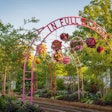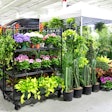
While in-person events are cautiously making a comeback, the ripple effects of the pandemic continue to show up in unexpected ways. One of those is in the floral industry, which is currently experiencing unprecedented supply shortages and other challenges.
“The flower supply business has always been susceptible to many influences that regularly control the price of flowers—weather, natural disasters, labor strikes in other countries and, of course, transportation logistics,” explains Linda Terrana, floral manager for BOLD Catering & Design in Atlanta. “Today, however, COVID's impact on the industry has created a ‘perfect storm’ across the industry, and companies large and small have been experiencing massive, unprecedented shortages.”
Terrana explains that the pandemic has dramatically changed the way growers and farms are managed, with many closing or being forced to pare back production costs. “Many did not survive the economic downturn, especially those in South America and Africa. Holland seems to have ridden the storm out and is rebuilding its inventory," she notes. "Across the U.S., there have been dramatic shortages in workers, plant materials, and bulbs and seeds."
In addition to the growers having less inventory, supply chain issues are also at fault, add Danielle Flores-Gary and Katie Hartman, co-owners of Los Angeles-based event floral design studio Floral Crush. “While everyone is excited about events ramping up again, we are experiencing a number of hurdles that are all a direct result of the pandemic,” says the duo. “Almost everything having to do with florals has increased in price, from the paper that wraps the flowers for transport to the freight charges. Every little element that goes into getting the product from the fields into our hands has increased.”
The labor shortage—meaning fewer freelance designers and support staffers—is also a hurdle, note Flores-Gary and Hartman. “In our market, a lot of the floral design studios rely on freelance designers. While we used to have a pretty solid roster of people to call on for events, the list has greatly diminished during the pandemic,” they explain. “Now, a lot of us are competing to get the best designers on our teams. As a result, many designers have increased their freelance rates because they know there is such a demand for their talent.”
To top it off, these factors hit at a time when consumer interest in flowers was sky-high as the country began to ease restrictions last spring and summer, causing an influx of rescheduled weddings and other events. Terrana notes that the demand for flowers has exceeded all expectations. “All of the holidays saw record sales of flowers, especially for Valentine’s Day, Mother’s Day, Easter, etc. There has been little to no time for the market to take a break and for farms to replant and replenish,” she says.
“The floral industry is in a really unique space right now,” agree Flores-Gary and Hartman. “A seasoned floral designer, along with a long-standing, reputable design company, will make all the difference,” advises Linda Terrana, floral manager for BOLD Catering & Design in Atlanta.Photo: Annie Duncan
“A seasoned floral designer, along with a long-standing, reputable design company, will make all the difference,” advises Linda Terrana, floral manager for BOLD Catering & Design in Atlanta.Photo: Annie Duncan
So, how can event planners navigate these issues while still supporting the floral industry and keeping clients happy? Here are some tips.
Above all, show a little compassion.
The golden rule throughout the pandemic still applies. “The best way we as an industry can support these farmers is to continue to use them for orders and show grace and understanding when product is not as pristine as it may once have been, and request and demand refunds when only absolutely necessary,” explains Terrana.
Be prepared for substitutions.
Terrana continues, “It is also our responsibility to educate our clients and temper expectations that it may not be possible to provide a specific shade and color of a flower in the current climate. Focus more on a style and color palette rather than specific flora stems and varieties.”
Dera Lee, the CEO and founder of New York-based event production and design agency Dera Lee Productions, has experienced this first-hand. “We recently ordered 250 specialty roses for an upcoming event and they didn't arrive due to the unforeseen shortages, so we found a similar floral that was already in the flower market that day,” she says. "We are preparing all our clients for the possibilities of their flowers not arriving as planned, and sharing alternative flower backup possibilities.”
Consider increasing your budget.
“You should also advise clients to be prepared for a budget increase,” says Terrana, noting that she’s seen a 30-50% price-per-stem increase.
Flores-Gary and Hartman are also seeing massive spikes in prices. “For example, a Cymbidium orchid that usually costs $18-$20 per stem was recently quoted at $45/stem,” they say. “We’ve tried to avoid passing these costs onto our clients by providing alternative floral options, but even basic florals that we use daily are skyrocketing. For example, white roses, a staple for events, are over 200% higher than their usual cost.”
Prioritize experience and stability.
For event planners looking to vet floral vendors right now, Terrana suggests prioritizing experience and stability. “A seasoned floral designer, along with a long-standing, reputable design company, will make all the difference,” she advises. “This is not necessarily the time to find a startup, niche floral designer or the time to look for favors and family friends to do your florals.”
For her part, Terrana has been leaning on long-time, established relationships with wholesalers and farms and buying in large volumes. BOLD has been able to meet clients’ requests with occasional substitutions, she says, but “it has required constant communication with the farms and suppliers to ensure the product we need will arrive in time and in good condition.”
Book your design team early—and communicate frequently.
“The demand is high,” continues Terrana. “Planners should keep in constant contact with their floral team and have honest communication with their clients to keep them updated on availability. It is also the planner’s role to keep the clients calm and reassured—and to be honest above all.”
Lee agrees, noting that she’s been in frequent communication with her florist partners and flower wholesalers, and actually received a letter from a Los Angeles-based floral partner in June explaining the supply challenges and urging flexibility on substitutions and pricing. “After reading the letter, I was surprised to see that the shortages have been going on since March,” she remembers.
Consider alternate options.
If the florals you want simply aren’t available, Terrana notes a few alternative decor ideas. “Candles, foraged natural greenery and upgraded higher-end linens are wonderful alternatives for table decor to achieve an elevated look,” she suggests.
“Also to offset the rise in price, most large design companies have a large inventory of silk and faux floral,” Terrana continues. “The quality of faux floral has improved so dramatically in the past few years, it’s nearly impossible to tell the difference with the real touch feel and softness of the faux. Consider using those in tall places where the eye goes and the hands do not. Your average guest will never know the difference.”
But support the flower industry when you can—and know that it will bounce back.
“It's an interesting time, for sure,” say Flores-Gary and Hartman. “We’re definitely glad to be back to work, and as event people, we thrive in these high-stress situations where you don’t know what’s around the next corner. If any industry can handle this much uncertainty, it’s ours.”



















